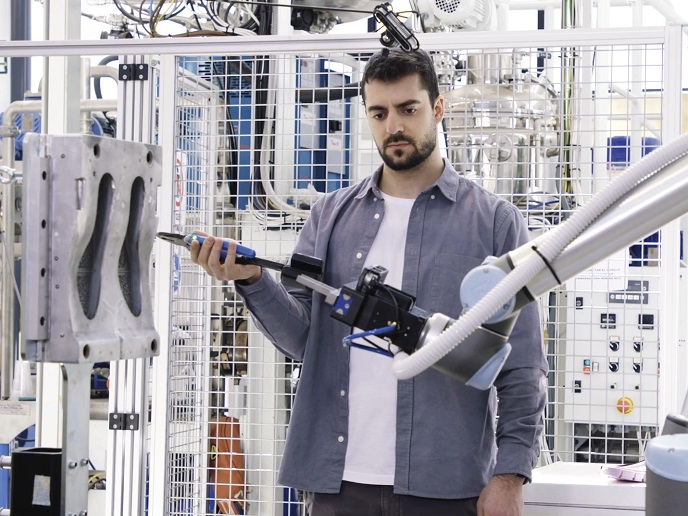In safe hands: intelligent robots expertly manipulate soft objects
While there are many robotic manufacturing systems for working with rigid objects, options remain limited for deformable materials. “The multi-fingered robots available are designed for limited applications, and have problems with durability, cost and operation,” says Youcef Mezouar, project coordinator of the EU-funded project SoftManBot (Advanced RoBOTic Technology for Handling SOFT Materials in MANufacturing Sectors). As manufacturing robots sometimes physically interact with humans, safe movement is also paramount, adding to the challenge. The SoftManBot project developed an AI-driven robotic solution based on customised grippers and multiple sensors – tactility, force, proximity and vision. “Our robot’s perception and control systems mimic the dexterity of manual operators, increasing manufacturing quality and productivity. This is more than just a technical achievement, it is a paradigm shift,” explains Mohammad Alkhatib, the project’s technical manager.
Mimicry to be mastered
Four pilots were run to demonstrate two key manufacturing tasks. The first was the extraction of products from moulds. While the injection of liquids into moulds to form component parts is usually automated, removal is typically manual, due to the dexterity required. The second task was the assembly of products made from complex multi-material components with various properties, including differences in rigidity, colour, stickiness, shape, weight and texture. This requires precise positioning, controlled deformation and different methods for joining components. SoftManBot’s solutions for the first task were demonstrated in a Spanish pilot with Plastinher Urbán, removing footwear soles from moulds, in a sporting apparel pilot with Decathlon in Albania, and in another pilot producing tyres with Michelin in France. The second task was undertaken in the Juema (website in Spanish) pilot in Spain, involving both extraction and assembly of toy parts. “Our very different pilots all benefited from each other, extending the capacities of our solutions, saving development time and money,” adds Mezouar, director of the school of engineering sciences at Clermont Auvergne INP (website in French), the project host.
Toy story
To assemble a doll, individual parts are typically manually extracted from moulds using sticks and pliers. The parts are then manually fitted to each other using pre-fixed holes and joints. Both processes require fast and highly dextrous movements. To mimic this efficiency, SoftManBot developed a robotic system capable of quickly processing the quantities, colours and textures of parts, along with two specialist grippers – a pneumatic one, capable of high forces for demoulding, and a large stroke electric gripper for assembly. Once the raw materials were set to form the parts required, operators activated the robots. Onboard cameras helped the robots detect the moulds before the best grasping points were determined by algorithms. Next, pressure and tactile sensors enabled the robots to apply the control and force needed to extract the parts. For assembly, the robots first separated the parts, tracking their deformation during handling, then selected the best grasping points to assemble the doll, guided by the blueprints, pressure and tactile sensors, and software-based decision-making. “The results were impressive, with our robotic system demonstrating impressive dexterity and consistency. On average the system successfully demoulded over 120 parts (legs, heads, etc.) 96 % of the time, and successfully assembled over 40 complete dolls,” notes Alkhatib.
Human-centred team players
To ensure the acceptance, comfort and trust of operators, SoftManBot has incorporated human needs into their solution’s design. While the automation of physically demanding tasks already helps lessen the chance of repetitive strain injuries, the system also provides a real-time ergonomic measurement of operators’ fatigue and stress. Additionally, task management algorithms include a visual sensing system that tracks human presence, enabling the robots to adjust their movements as required. “At the beginning of the project, less than 40 % of workers/operators we asked supported our proposals, many afraid of losing their jobs. After demonstrating the technology and providing training, this rose to over 70 %, with operators seeing the robots more as assistants,” remarks Mezouar. The project has already shared their research in over 30 research papers and also plans to make a toolbox of scientific assets available to researchers interested in soft object manipulation.
Keywords
SoftManBot, robot, manufacturing, textile, moulds, AI, sensors







